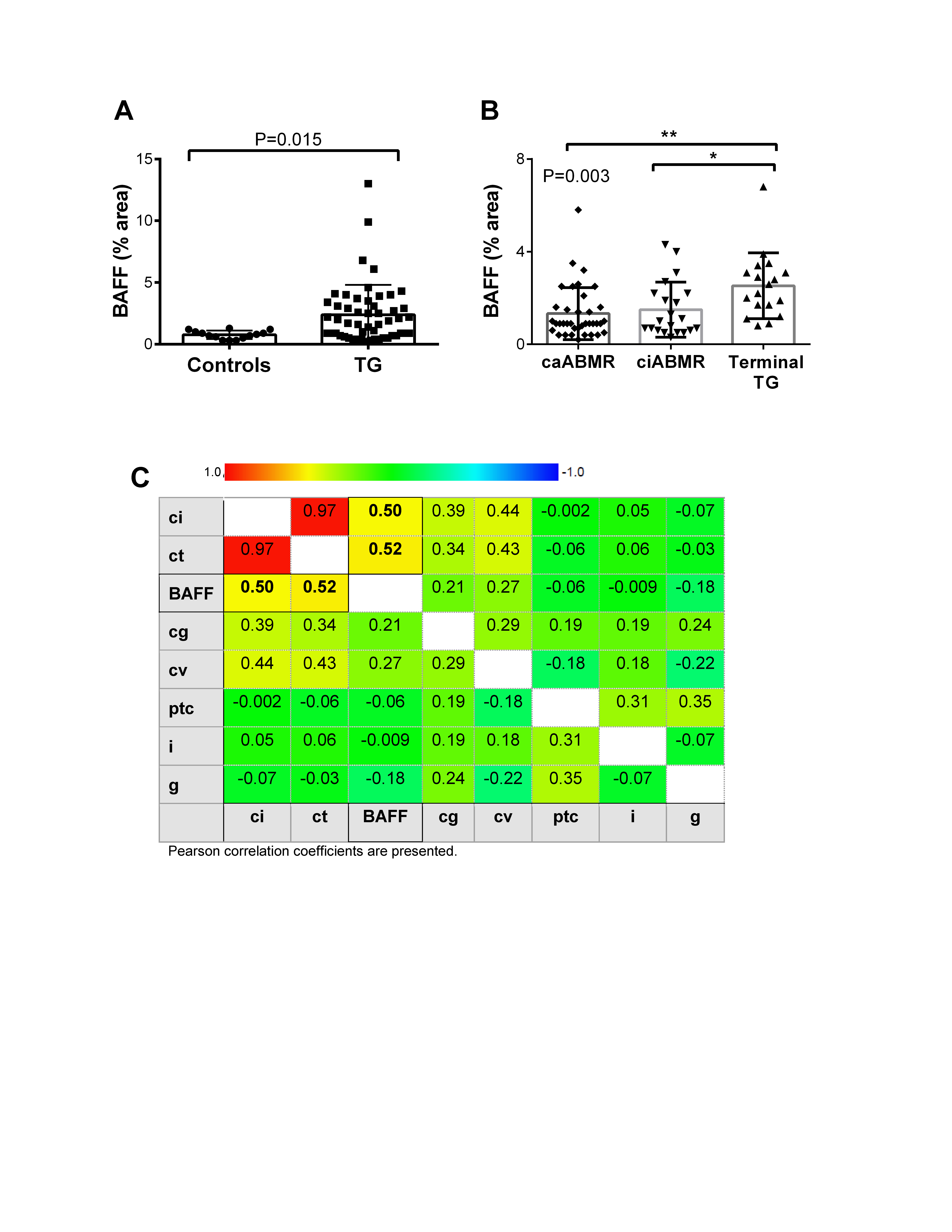Intrarenal B-cell Activating Factor (BAFF) Levels are Increased in Transplant Glomerulopathy
University of Wisconsin Madison, Madison, WI
Meeting: 2021 American Transplant Congress
Abstract number: 220
Keywords: B cells, Graft failure, Kidney transplantation, Rejection
Topic: Clinical Science » Biomarkers, Immune Assessment and Clinical Outcomes
Session Information
Session Name: Biomarkers, Immune Assessment and Clinical Outcomes - III
Session Type: Rapid Fire Oral Abstract
Date: Monday, June 7, 2021
Session Time: 4:30pm-5:30pm
 Presentation Time: 4:45pm-4:50pm
Presentation Time: 4:45pm-4:50pm
Location: Virtual
*Purpose: Transplant glomerulopathy (TG), a key feature of chronic active antibody-mediated rejection (caABMR), is associated with allograft failure. B-cell activating factor (BAFF) is a cytokine integral to B cell function and survival. In several diseases, such as lupus nephritis, intrarenal BAFF levels correlate with renal disease activity. We hypothesized renal tissue BAFF levels are increased in TG and are associated with allograft failure.
*Methods: Kidney transplant recipients that underwent biopsy between 2014-2015 and had a diagnosis of TG (cg score ≥1a) were compared to a group of controls (negative for rejection). The TG cohort was further stratified into 3 subgroups, based on Banff 2019 criteria: caABMR, chronic inactive ABMR (ciABMR), or terminal TG (chronicity score ≥ 8). Tissue BAFF staining was measured by densitometry and reported as percent area. Allograft failure was defined as re-transplant, return to dialysis, or death.
*Results: Of the 120 recipients in the study, 82 (68%) had graft failure over a median follow-up of 2.8 years after biopsy. Patients with TG (n=106) versus controls (n=14) had a higher rate of allograft failure (70% vs 32%, P=0.02) and higher intrarenal BAFF levels (2.39 ± 0.34% vs 0.76 ± 0.09%, P=0.015, Figure 1A). At biopsy, the TG group had more proteinuria compared to controls (1.5 ± 1.8 vs 0.2 ± 0.1 g/g, P<0.001), and more DSA, particularly class II DSA (54% vs 16% were positive for class II DSA, P<0.001). There were significant differences in tissue BAFF levels when stratified by TG subgroup: caABMR 1.33 ± 0.33%, ciABMR 1.50 ± 0.33%, and terminal TG 2.53 ± 0.39% (1-way ANOVA P=0.003, Figure 1B). Intrarenal BAFF levels correlated with tubular atrophy (R2=0.52, P<0.0001) and interstitial fibrosis (R2=0.50, P<0.0001), but not microvascular inflammation (Figure 1C). On univariate analysis, intrarenal BAFF was not associated with risk of graft failure/death (HR=1.05 (95% CI 0.61-1.79), P=0.8). On multivariate analysis, cg score (aHR 1.44 (95% CI 1.08-1.92), P=0.01), proteinuria (aHR 1.22 (95% CI 1.04-1.43), P=0.01), and serum creatinine at biopsy (aHR 2.18 (95% CI 1.64-2.89), P<0.0001) were associated with graft failure/death.
*Conclusions: Tissue BAFF levels are increased in transplant glomerulopathy, but were not associated with allograft failure or death. These findings suggest a role for BAFF in renal injury and TG. As anti-BAFF therapeutics are now clinically available, further studies are needed to evaluate BAFF levels in the circulation and lymphoid tissues in transplant recipients and its impact on B cell populations, DSA, and ABMR.
To cite this abstract in AMA style:
Panzer S, Swanson K, Pandya G, Hidalgo L, Reese S. Intrarenal B-cell Activating Factor (BAFF) Levels are Increased in Transplant Glomerulopathy [abstract]. Am J Transplant. 2021; 21 (suppl 3). https://atcmeetingabstracts.com/abstract/intrarenal-b-cell-activating-factor-baff-levels-are-increased-in-transplant-glomerulopathy/. Accessed December 17, 2025.« Back to 2021 American Transplant Congress

